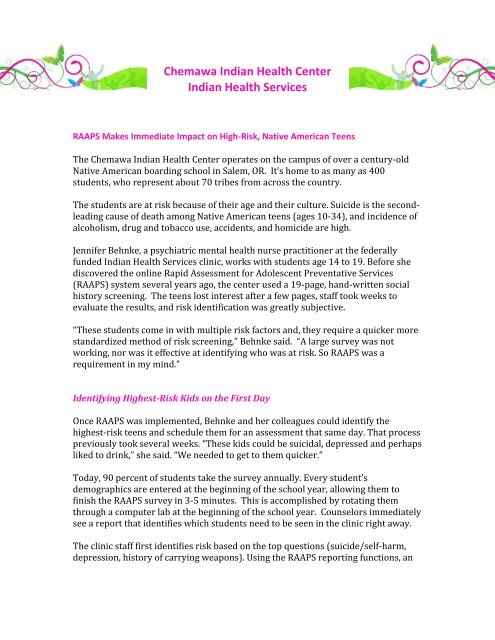Read more - Rapid Assessment for Adolescent Preventive Services
Read more - Rapid Assessment for Adolescent Preventive Services
Read more - Rapid Assessment for Adolescent Preventive Services
You also want an ePaper? Increase the reach of your titles
YUMPU automatically turns print PDFs into web optimized ePapers that Google loves.
Chemawa Indian Health Center<br />
Indian Health <strong>Services</strong><br />
RAAPS Makes Immediate Impact on High-Risk, Native American Teens<br />
The Chemawa Indian Health Center operates on the campus of over a century-old<br />
Native American boarding school in Salem, OR. It’s home to as many as 400<br />
students, who represent about 70 tribes from across the country.<br />
The students are at risk because of their age and their culture. Suicide is the secondleading<br />
cause of death among Native American teens (ages 10-34), and incidence of<br />
alcoholism, drug and tobacco use, accidents, and homicide are high.<br />
Jennifer Behnke, a psychiatric mental health nurse practitioner at the federally<br />
funded Indian Health <strong>Services</strong> clinic, works with students age 14 to 19. Be<strong>for</strong>e she<br />
discovered the online <strong>Rapid</strong> <strong>Assessment</strong> <strong>for</strong> <strong>Adolescent</strong> Preventative <strong>Services</strong><br />
(RAAPS) system several years ago, the center used a 19-page, hand-written social<br />
history screening. The teens lost interest after a few pages, staff took weeks to<br />
evaluate the results, and risk identification was greatly subjective.<br />
“These students come in with multiple risk factors and, they require a quicker <strong>more</strong><br />
standardized method of risk screening,” Behnke said. “A large survey was not<br />
working, nor was it effective at identifying who was at risk. So RAAPS was a<br />
requirement in my mind.”<br />
Identifying Highest-Risk Kids on the First Day<br />
Once RAAPS was implemented, Behnke and her colleagues could identify the<br />
highest-risk teens and schedule them <strong>for</strong> an assessment that same day. That process<br />
previously took several weeks. “These kids could be suicidal, depressed and perhaps<br />
liked to drink,” she said. “We needed to get to them quicker.”<br />
Today, 90 percent of students take the survey annually. Every student’s<br />
demographics are entered at the beginning of the school year, allowing them to<br />
finish the RAAPS survey in 3-5 minutes. This is accomplished by rotating them<br />
through a computer lab at the beginning of the school year. Counselors immediately<br />
see a report that identifies which students need to be seen in the clinic right away.<br />
The clinic staff first identifies risk based on the top questions (suicide/self-harm,<br />
depression, history of carrying weapons). Using the RAAPS reporting functions, an
analysis of the entire population is done in a matter of hours and the highest-risk<br />
youth are triaged <strong>for</strong> immediate follow-up.<br />
RAAPS also flags students who have never been in trouble nor been red-flagged in<br />
previous screenings. Some of these students have been included in a wilderness<br />
therapy program, which the teens report as providing life-changing experiences.<br />
“The RAAPS made a powerful difference in those cases, by identifying those teens<br />
that were flying under the radar” Behnke said.<br />
Clinic-wide Efficiency and Effectiveness<br />
Behnke initially was impressed with RAAPS because “the survey was quick, secure,<br />
validated, online, inexpensive, easy to license, and easy to use,” she said.<br />
“And the kids are generally <strong>more</strong> honest with a computer than with a human sitting<br />
there asking them questions,” she added. “This helps to ensure better quality data,<br />
<strong>more</strong> consistent data, and, there<strong>for</strong>e, better screening.”<br />
Behnke’s team includes a Psychologist, a Licensed Professional Counselor, and a<br />
Behavioral Health Case Manager. Her director is a Licensed Clinical Social Worker.<br />
The entire staff embraced the survey quickly and recognized the improved<br />
efficiency and effectiveness of the clinic. “The reduction in hours from what were<br />
needed to assess the previous screenings and database the results easily pays <strong>for</strong><br />
the system”, Behnke said.<br />
“This has vastly improved our overall practice. It reduces time and improves the<br />
accuracy of identifying teens at risk in a <strong>more</strong> consistent and objective way,” Behnke<br />
said. “This helps us help <strong>more</strong> kids <strong>more</strong> effectively.”<br />
“What could be better than that?”


